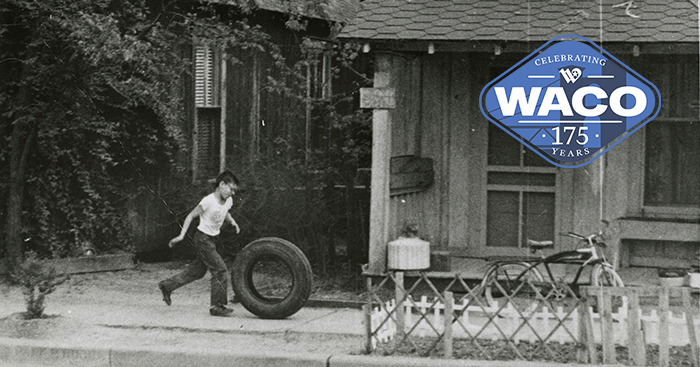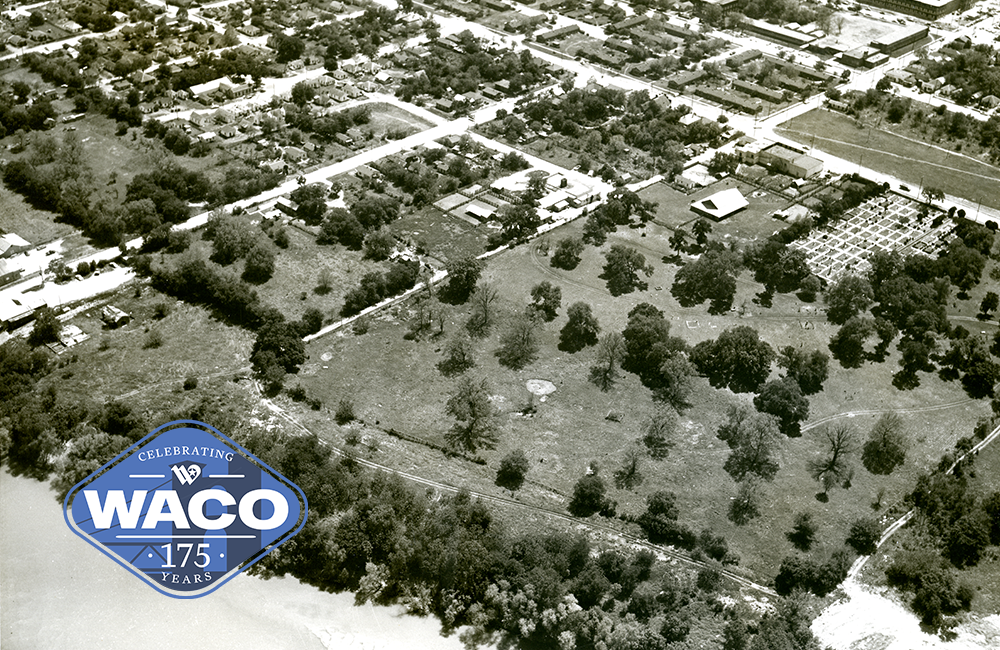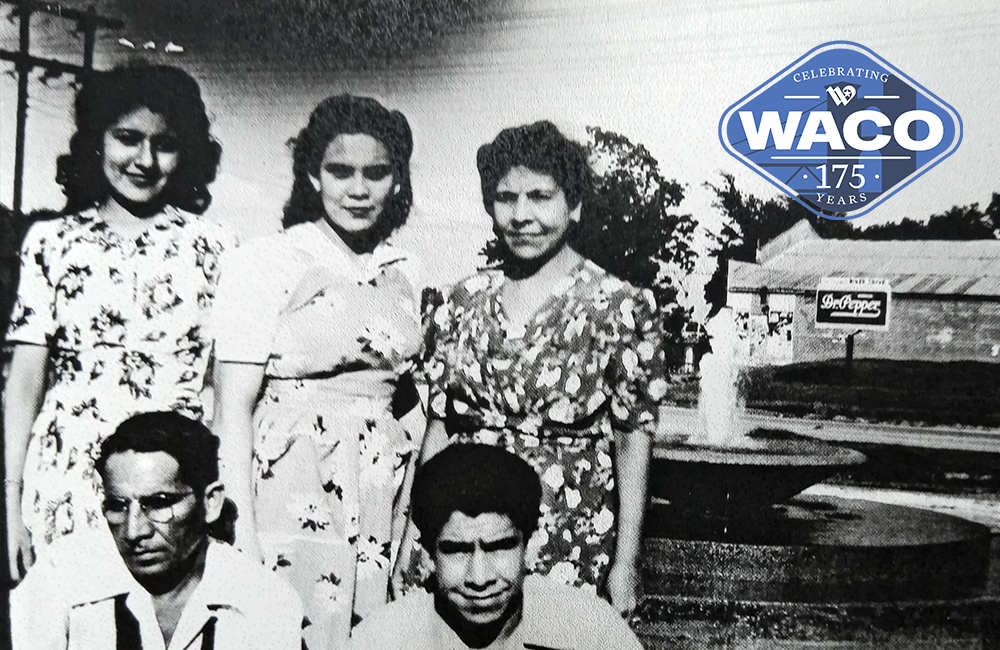Lost Barrios: Remembering Sandtown and Calle Dos
Created
on September 26, 2024 at 08:00 AM

Calle Dos in the 1960s near St. Francis Catholic Church. Photo courtesy of the Baylor University Texas Collection.
Spanish Harlem, East Los Angeles, and Little Havana are among the best-known Hispanic neighborhoods in the United States. But have you heard of Calle Dos or Sandtown? In the early 20th century, both neighborhoods served as thriving hubs for Waco’s Hispanic community.
Sandtown

General area of Sandtown with the First Street Cemetery in the 1960s. Photo Courtesy of the Texas Collection.
Sandtown emerged in the early 1900s as a primarily Hispanic neighborhood roughly between the Brazos River and Third Street and between the Jackson/Katy Railroad and Jones Street near where the present-day Texas Sports Hall of Fame is located. The name reportedly comes from the sand that would blow with the wind from the Brazos River.
Sandtown featured residences, small groceries and other businesses, meat packing plants, Sunbright Paper, two cemeteries, and the segregated African American Moore High School. The San Antonio and Aransas Pass Railroad, which later became the Southern Pacific Railroad, traveled down First Street through the neighborhood on its way south through Asa, Downsville, Chilton, Rosebud, Cameron, and beyond.
While not all homes had indoor plumbing or other modern-day amenities, Sandtown residents recall a strong sense of community. In the 1950s and 1960s, urban renewal led to the dismantling of the neighborhood and relocation of businesses and residences. Interstate 35 now cuts through where the neighborhood was located.
Calle Dos

La Pila in the Calle Dos Neighborhood in the 1960s. Photo Courtesy of the Waco Hispanic Museum.
The Calle Dos neighborhood became home to Mexican American workers and Mexican Revolution refugees after legal prostitution ended in Waco as the result of the opening of Camp Macarthur in 1917 during World War I. Calle Dos included the area between the Brazos River, Fourth Street, Washington Avenue and present-day Waco Drive. St. Franics on the Brazos Catholic Church, Primera Iglesia Bautista, and La Sociedad Mutualista Mexicana de Jornaleros served as community anchors for the neighborhood. For many years, la plataforma was an outdoor social hub for the neighborhood where la Mutualista hosted multiple events and dances like celebrations for Mexican Independence Day on September 16.
Another focal point of the neighborhood was La Pila, a natural water-fed fountain at Jefferson and present-day University Parks Drive, where many residents, especially young people, enjoying playing and spending time. Like Sandtown, Calle Dos existed until the 1950-60s, when urban renewal led to the relocation of residents and clearing of the land.
In the nearly 60 years since the Sandtown and Calle Dos neighborhoods were overtaken by urban renewal, Waco’s Hispanic population has both dispersed and grown significantly throughout the city. The legacy of these barrios lives on in our long-standing Hispanic residents. Their stories of resilience, community, and cultural preservation are an integral part of Waco’s history.
Preserving Heritage

La Pila in the Calle Dos Neighborhood in the 1960s. Photo Courtesy of the Waco Hispanic Museum.
Today, Waco is actively working to honor its Hispanic heritage. As part of the City of Waco’s 12-to-20-year downtown redevelopment plan, the City is developing Calle Dos Plaza that will extend from St. Francis Catholic Church to La Pila Fountain, incorporating an entertainment pavilion.
Across town, Waco Parks & Recreation is collaborating with the Hispanic community to create a heritage trail and a regional park at the old Floyd Casey Stadium site to commemorate local Hispanic history. The upcoming regional park will feature a connection to the South Waco Community Center, which houses the Waco Hispanic Museum.
While we cannot undo the loss of Calle Dos and Sandtown, we can honor the legacy of these vibrant communities and the people who called them home. Through these initiatives like the Calle Dos Plaza and the Hispanic Heritage Trail, the City of Waco is committed to preserving and celebrating its rich Hispanic heritage. These efforts pay tribute to the past and ensure that the stories, traditions, and contributions of the Hispanic community continue to shape Waco’s identity for generations to come.
Continued Learning
Visit the Waco Hispanic Museum

"La Pila" by Rodolfo "Loco" Rodriguez.
The Waco Hispanic Museum is housed in South Waco Community Center, and it offers a collection of art, photos, news articles, and clothing from residents who made up Waco's Hispanic community. The museum preserves Hispanic culture and promotes Hispanic involvement in Waco and Central Texas. To make an appointment to visit the museum, contact Louis Garcia at (254) 548-9730 or blackcow54@yahoo.com.
The painting, "La Pila" is one of many historical artifacts at the museum. It was created by Rodolfo "Loco" Rodriguez. The painting features a visualization of the rustic neighborhood and kids playing in the neighborhood around Second and Third Streets and Jefferson Avenue.
Sandtown, A Vanished Waco Neighborhood
Sources
Pierson, Marla. “Hispanic heritage heralded”. Waco Tribune-Herald, 26 Nov 1997, p. 1A
“Sandtown, a Vanished Waco Neighborhood.” City of Waco Productions, Waco
City Cable Channel, https://mywacotv.com/video/sandtown-a-vanished-waco-neighborhood-waco-gateway-to-texas-history
Smith, J.B. “Uncovering history”. Waco Tribune-Herald, 23 Jun 2017, p. 1A
Werner, Karen Svendsen. “Hispanics leave lasting mark on Waco area”.
Waco Tribune-Herald, 27 Apr 1986, p. 12.